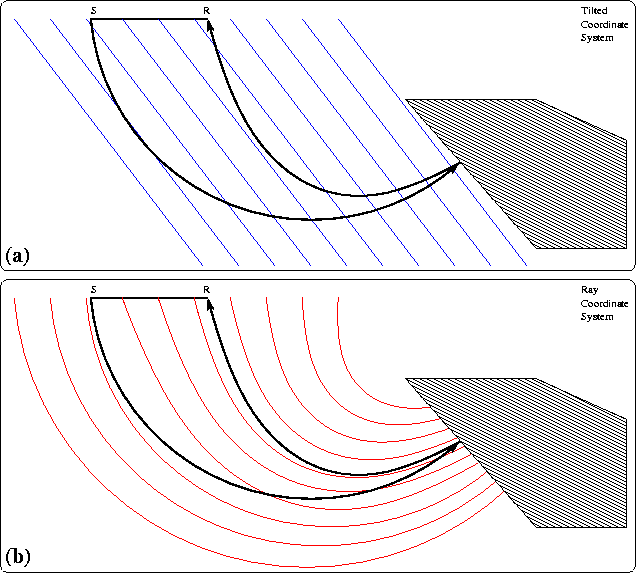




Next: Acoustic wave-equation in 3-D
Up: Sava and Fomel: Riemannian
Previous: Sava and Fomel: Riemannian
Imaging complex geology is one of the main challenges of today's
seismic processing.
Of the many seismic imaging methods available,
downward continuation Claerbout (1985) has
proven to be accurate, robust, and capable of handling
models with large and sharp velocity variations.
In addition, such methods naturally handle the multipathing
which occurs in complex geology and provide a band-limited
solution to the seismic imaging problem.
Furthermore, as computational power increases, such methods
are gradually moving into the mainstream of seismic
processing.
However, migration by downward
continuation imposes strong limitations on the dip of reflectors
that can be imaged since, by design, it favors energy which is
propagating mainly in the downward direction.
Upward propagating energy, e.g., overturning waves,
can be imaged in principle using downward continuation
methods Hale et al. (1992), although the procedure
is difficult, particularly for prestack data.
In contrast, Kirchhoff-type methods based on ray-traced
traveltimes can image steep dips and handle
overturning waves, although those methods are far less
reliable in complex environments given their high-frequency
asymptotic nature.
The steep-dip limitation of downward continuation techniques has
been addressed in several ways:
- A first option is to increase the
angular accuracy of the extrapolation operator, for example by
employing methods from the Fourier finite-difference (FFD)
family Biondi (2002); Ristow and Ruhl (1994), or the
Generalized Screen Propagator (GSP) family
Huang and Wu (1996); de Hoop (1996).
The enhancements brought about by these methods
come at a price, since they increase the cost of
extrapolation without guaranteeing unconditional stability.
- A second option is to perform the wavefield extrapolation
in tilted coordinate systems Etgen (2002),
or by designing sources which favor illumination of
particular regions of the image
Chen et al. (2002); Rietveld and Berkhout (1994).
We can thus increase angular accuracy, although those methods
favor a subset of the model (a salt flank, for example),
while potentially decreasing the accuracy in other regions.
In complex models it is also not obvious what is an optimal
tilt angle for the extrapolation grid.
- A third possibility is hybridization of
wavefield and ray-based techniques, either in the form
of Gaussian beams
Gray et al. (2002); Hill (1990, 2001),
coherent states
Albertin et al. (2001, 2002),
or beam-waves
Brandsberg-Dahl and Etgen (2003).
Such techniques are quite powerful, since they
couple wavefield methods with
multipathing and band-limited properties, with
ray methods, which deliver arbitrary directions
of propagation, even overturning.
The main strength of those techniques, is also their main
weakness, i.e. they are formulated in terms of decoupled
beams. Beams may leave shadow zones in various parts
of the model, which hamper their imaging abilities.
Furthermore, beams have limited size, which in turn limits
the extent of the diffractions created by sharp features
in the model to
that of any particular beam, no matter how accurate the
extrapolator within each beam is. In addition, the narrow
extrapolation domain poses serious beam superposition
problems, such as beam boundary effects.
The main idea of our paper is to couple the beams together
and extrapolate within all of them at once. We, therefore,
cannot talk about beams anymore, but instead we need to
talk about continuously changing coordinate systems.
We extend downward continuation in a regular Cartesian space
to wavefield extrapolation in distorted coordinates,
known as Riemannian spaces , thus the name of our method.
We formulate the theory in arbitrary
3-D semi-orthogonal Riemannian spaces, e.g., ray coordinates,
although those coordinate systems do not necessarily need
to have a physical meaning as long as they fulfill the
semi-orthogonality condition.
Examples of such coordinate systems include, but are not limited
to, fans of rays emerging from a source point,
or bundles of rays initiated by plane waves of arbitrary
initial dips at the source.
A special case of our method is represented by the polar/spherical
coordinate system
Nichols and Palacharla (1994); Nichols (1994, 1996).
Our method can be seen as a finite-difference solution to the
acoustic wave-equation in ray coordinates. In this respect, it
is closely related to Huygens wavefront tracing
Sava and Fomel (2001), which represents a finite-difference
solution to the eikonal equation in ray coordinates.
Another idea related to our method is that of
wave-equation in ray-centered coordinates
Cervený (2001); Yedlin (1981).
However, our method is different since the
ray-centered coordinate system is orthogonal in 3-D
and defined around an individual ray.
In contrast, our method is formulated in ray coordinates
which are parameterizations of the wavefields at the source,
and which are non-orthogonal in 3-D and
defined globally for an entire family of rays.
The upside of our method is that the coordinate system
may follow the waves, and can even overturn, such that
we can use one-way extrapolators to image diving waves
(Figure 1).
overturned
Figure 1
Ray coordinate systems are superior to tilted coordinate
systems for imaging overturning waves using one-way
wavefield extrapolators.
Overturning reflected energy may become evanescent
in tilted coordinate systems (a),
but stays non-evanescent in ray coordinate systems (b).
|
|  |

We can also use
extrapolators with small angle accuracy (e.g.  ),
since, in principle, we are never too far from the actual
direction in which waves propagate.
We are also not confined to the extent
of any individual beam, therefore we can track diffractions
for their entire spatial extent.
),
since, in principle, we are never too far from the actual
direction in which waves propagate.
We are also not confined to the extent
of any individual beam, therefore we can track diffractions
for their entire spatial extent.





Next: Acoustic wave-equation in 3-D
Up: Sava and Fomel: Riemannian
Previous: Sava and Fomel: Riemannian
Stanford Exploration Project
10/14/2003
